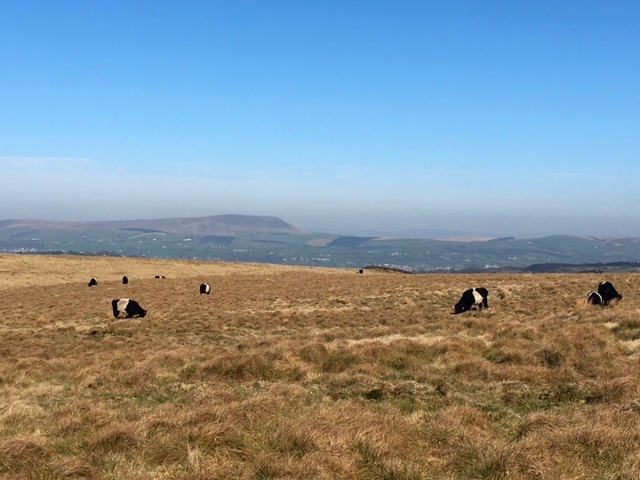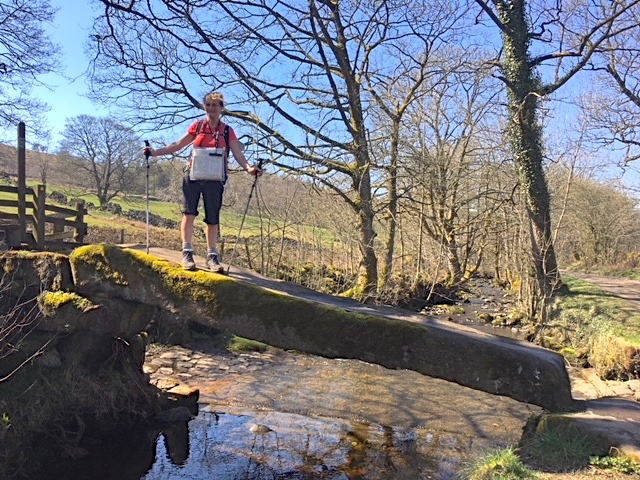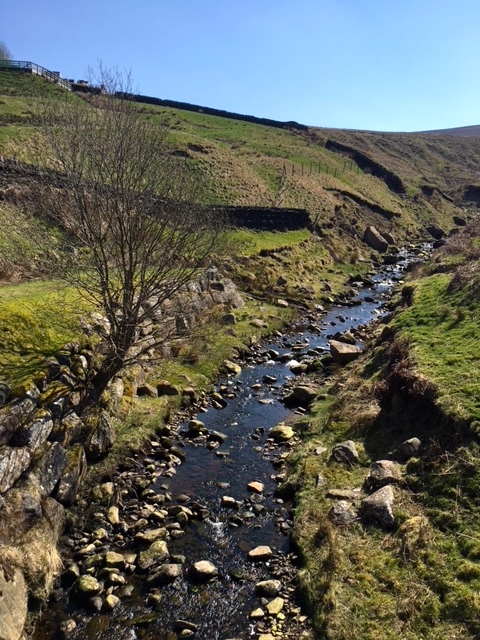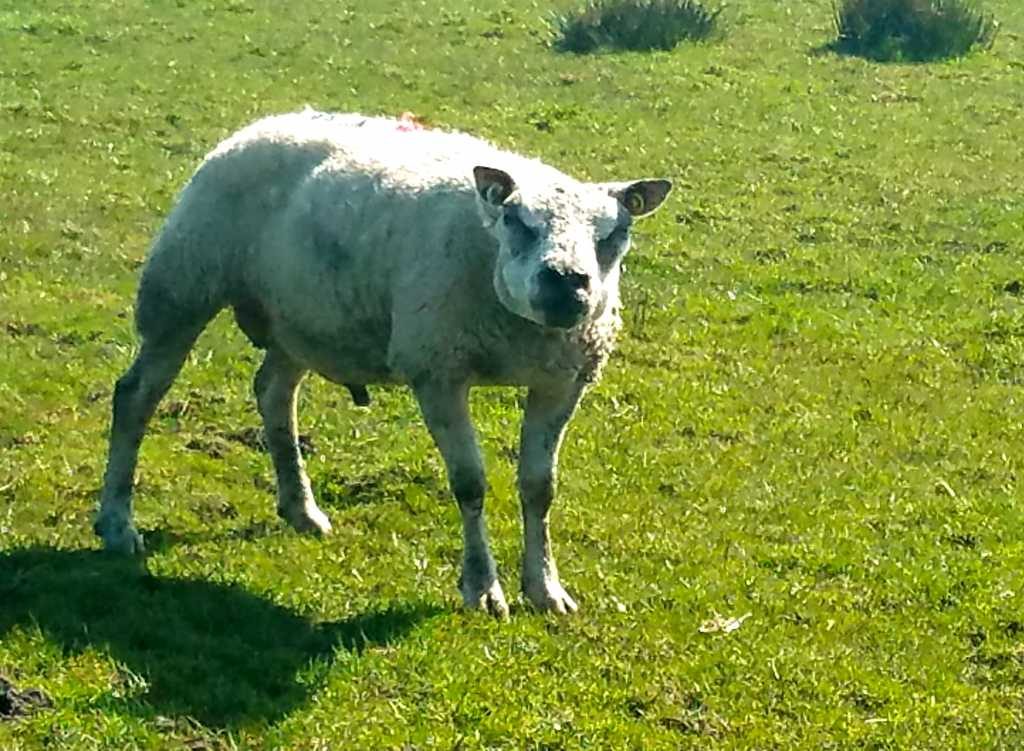From: Worsthorne to Kelbrook
Distance: 14m / 22.4
Cumulated distance: 585m / 941km
Percentage completed: 56.9

Skiers have an expression for days like today. They call it a ‘Bluebird Day’ .. cloudless blue skies with the sun shining down from dawn till dusk. We’d had an inkling of what was coming when we saw the sunset yesterday evening, spilling over Pendle Hill.

Sunset over Pendle Hill, sadly notorious for being the location of the execution of the Pendle witches in the 17th century
There was a fairly long walk ahead of us today to Kelbrook, so we headed off early, straight after breakfast. The map revealed the criss-crossing of a patchwork of public paths, indicating just how popular the moorland area is among walkers. We first had to retrace our steps for a mile or so, up the ancient Gorple Road. It was originally the main artery for the woollen trade between industrial East Lancashire and the Calder Valley of Yorkshire, way before the days of railways and canals. It climbs high over the Pennines on a lonely, isolated route but we left it not far from Worsthorne, to rejoin the Pennine Bridleway.
The views were sublime. First there were pastoral scenes, with the ubiquitous sheep and lambs.

Outskirts of the village of Worsthorne
But as we headed on to the Bridleway, very quickly the landscape changed to wide empty moorland. Each area of moor merged seamlessly into the next. It was only by looking on the map that you could identify their different, enchanting names: Entwistle Moor, Red Spa Moor, Bedding Hill Moor, Pot Brinks Moor and Enmost Moor, to name but a few.

Swinden Reservoir beyond Wasnop Edge

Day-time Pendle Hill
The trials of the Pendle witches in 1612 are among the most famous witch trials in English history, and some of the best recorded of the 17th century. The twelve people accused lived in the area surrounding Pendle Hill. They were charged with the murders of ten people by witchcraft. Of the eleven who went to trial, nine women and two men, ten were found guilty and executed by hanging; one was found not guilty. We were told by locals that the hangings took place at the foot of Pendle Hill. In today’s weather it was difficult to believe.
Of course there were a few sheep to be seen on the moors .. as well as some woolly saddle-back cattle.

Sheepy poseurs

Cattle oblivious to the views

Curious calf
It felt very good to be heading north again. We sat and drank tea and ate good (but far from divine) flapjack, overlooking the little village of Thursden, in its wooded valley. To the right were the moors which are probably haunted to this day, by the ghosts of Heathcliff and Cathy. The Bronte sisters, Charlotte, Emily and Anne and their wayward brother, Branwell, lived at the vicarage in Haworth, over to the east. It was easy to see what inspired the desolation which pervades many of their novels. The moors are beautiful today with the sun adding a feeling of optimism, but their unwooded bleakness on greyer days was not difficult to imagine. The PBW for a short distance, shared its path with the Bronte Way, which made my companion very happy, being a big fan of the sisters’ books.
The views just kept coming. And the sun kept shining.

Bridleway shared by walkers, horse-riders and cyclists

Beyond Trawden, looking back once again to Pendle Hill
About halfway through the day we arrived in Wycoller. I’d been looking forward to making a stop here, and not just for the tearoom, which looked every bit as enticing as I’d hoped. There are various ancient bridges which cross Wycoller Beck .. Pack-Horse Bridge, Clapper Bridge and Clam Bridge. Clam is a listed ancient monument and is a remarkable 1000 years old .. dating it to neolithic times. It’s really just a slab of stone across the banks but the thought of the footfall over the centuries is pretty amazing.

Clam Bridge
Wycoller Hall is believed to be the inspiration for Ferndean Manor in ‘Jane Eyre’. The one where Mr Rochester kept his mad first wife locked up in the attic. Charlotte Bronte would have passed through here on her way to Gawthorpe Hall when she went to stay with the Kay-Shuttleworths, so it’s easy to believe that it was her inspiration. The hall was pulled down in 1818 but the ruins are still believed to play host to spectral guests.

16th century Wycoller Hall
But the most interesting bit for me about Wycoller is the fact that Clapper Bridge played a role in ‘The Railway Children’, the best children’s film of all time, made in the 1970s. In a sequence from the film, Bobbie (Jenny Agutter) is seen sitting on the bridge, talking to Dr Forrest who is driving his pony and trap through the ford. I’ve lost count of the number of times I’ve seen it, never failing to cry at the ending, when Roberta is reunited with her father on the train station platform. At first the steam of the engine clouds her vision but then, as it slowly dissipates, she sees him standing there, returning to her life after several years in prison, where he had been wrongly incarcerated. I can still hear her crying out as she runs towards him arms outstretched, ‘Daddy, oh my Daddy’. My father and sister used to weep buckets at it too.

Brooks and streams along the way

Babbling brook

Mid-afternoon view over to Pendle Hill

Checking for trolls, ‘with eyes as big as saucers’
Regular readers of the blog will know I have a soft spot for sheep. Why else would I be walking through the lambing season. This afternoon we came across a huddle of sheep which was anything but cute, very far from being photogenic. In fact they looked more like bulldogs than sheep. Are any of you readers sheep officionados .. is this a breed or were they simply having an off day? They did cause us a lot of mirth .. but not until they were well out of earshot, of course, to save their feelings.

Bulldog sheep
After a couple more hills we came to a beautifully located pub for a very welcome swift half. It tasted like nectar. The view looked back over the day’s walk, giving us cause to pat each other on the back.

‘I’ll just have half’
From the Black Lane Ends pub we had a scant two miles to walk to Kelbrook, our stop for the night. There was some nifty map-reading and bog-dodging to do but it was a charming path mostly downhill to the village, with lapwings scooting through the air entertaining us with their beautiful song. Perfect end to a bluebird day.

Pretty Kelbrook overlooked by elves
And finally, to show that Yorkshire can do more than high brow, Kelbrook proudly tells you that the creator of the Wombles, Elisabeth Beresford, wrote much of ‘The Wandering Wombles’ while staying in the village. Residents of Kelbrook are affectionately known as Kelbricks in the area.
Black Dog Tails
Stella went from being a rescue dog to being a police dog, working tirelessly with officer Claire Todd.
![]()




I hope those waterproof trousers are packed away for good now. I had been expecting photos of you in shorts but rolled up to the knee trousers will have to do! Can’t believe how far you have got! Well done and keep going xx
Sad to say they were rolled down again today! But they can easily be pulled back up if the forecasters are right about tomorrow! xx
Oh my goodness Jules, you are going SO well and this weather, so beautiful. Spring will be showing all its colours. Philip and I had seemingly endless rain and even floods on our journey but a blue skied Spring day really makes the heart happy. Again, the photos and your writing bring the world you walk through alive for all who read of your adventure. xx
Marilyn, I think of you and Philip every morning when I take my tea-break. It has been particularly beautiful, stopping for a drink over the past few days .. with glorious sun lighting up glorious views. xx
Haha, we too have those grumpy sheep in the fields by us! I often wonder how such cute little lambs turn into such curmudgeons. Looks amazing scenery where you’re walking now.
They’re called Texels and apparently very good for their lean meat .. but you’re right, the lambs are utterly cute.
Into the Yorkshire Dales next I hope – my favourite area in the whole country. From a young age until the present I have walked, cycled, climbed and caved all over this wonderful limestone country. I do hope you get good weather and a route that takes in some of the best bits.
By the way I walked The Lancashire Witches Walk in day walks with my friend Bowland Climber in July 2016. You will find all the details on the Long Distance Walking Association website (recommended) and as far as I know the witches were hung near Lancaster Castle where they were taken for trial – it is all an interesting, but sad and woeful story well documented if you Google.
I’m really falling in love with the Dales! Had two fantastic days walking and being enthralled by the views. Can quite understand why you favour them. I am very much looking forward to reading your blogs as well as John’s when my walk is over .. just not enough time in the day at the moment.
So glad the weather is showing you the Pennines at their best! Makes up for the first few weeks!
They look sublime!
Glorious! So glad you are having such lovely weather – don’t get sunburned! Xx
I look tanned but actually it’s from all the wind I’ve encountered along the way! xx
Sunshine and moors, you lucky girl!
The flags will be cracking – that phrase you missed refers not to the ones up a pole but the ones on the pavement. According to folk lore if the sun is hot enough they might crack.
The ancient flagged paths of the Pennines were mule trails for transport and their worn surface a delight to walk, you may have already come across them. The flags more recently used on the Pennine Way and others for path repair generally have their origins on the floors of all those old cotton mills.
I’ll let you crack on with your walk but if you look left today you will see the lovely Bowland Fells.
Ahhh .. that all makes sense now. I have indeed walked on the worn surface of the mule trails and I had a brief encounter with the PW flagstones a few days ago. In a couple of days time I will be walking with friends for a good long stretch along them. So looking forward to it, especially now that I know more about their origin. Thank you so much.
The bulldog sheep look a bit like me getting up early for work!! XX
You could never in a month of Sundays look that grumpy, lovely Lindy! xx
A day from your imaginings – so perfect and plus…the ugliest sheep I’ve ever seen!! So lovely to see so much of an England that’s new to me. Lots of love from a boosey Friday night at Mamasan in Bondi xx
I think you’ve taken up permanent residence at Mamasan, Frannie! Can’t wait to join you there later in the year. xx
Hi Jules,
I hope you are enjoying the lovely warm weather we’ve had lately. You photographs reflects that really well.
Thank you for helping to destigmatize mental health.
Loved you sketch too.
Take care,
Simone x
Thanks for your comment, Simone .. I suspect it means you’re back from South America. SANE has been very quiet while you’ve been away. xx
Oh what a treat ! I am a bluebird day fan , blue sky makes me totally happy . Ladies , so happy for you it’s finally shorts and tee shirts weather , may it stay that way . Simply loving today’s magnificent views Jules , pastoral scenes , sunsets , ancient bridges and being plunged into all the British litterature . Thank you xx
Yes, it was definitely your sort of day yesterday, Sophie! Hope I can dig some of the same out for you in Scotland! xx